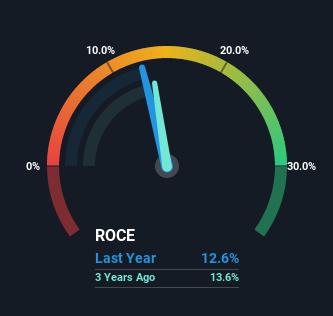If we want to find a stock that could multiply over the long term, what are the underlying trends we should look for? In a perfect world, we'd like to see a company investing more capital into its business and ideally the returns earned from that capital are also increasing. Basically this means that a company has profitable initiatives that it can continue to reinvest in, which is a trait of a compounding machine. That's why when we briefly looked at Stabilus' (ETR:STM) ROCE trend, we were pretty happy with what we saw.
Return On Capital Employed (ROCE): What Is It?
For those that aren't sure what ROCE is, it measures the amount of pre-tax profits a company can generate from the capital employed in its business. To calculate this metric for Stabilus, this is the formula:
Return on Capital Employed = Earnings Before Interest and Tax (EBIT) ÷ (Total Assets - Current Liabilities)
0.13 = €125m ÷ (€1.2b - €207m) (Based on the trailing twelve months to June 2022).
Therefore, Stabilus has an ROCE of 13%. In absolute terms, that's a satisfactory return, but compared to the Machinery industry average of 9.0% it's much better.
View our latest analysis for Stabilus

Above you can see how the current ROCE for Stabilus compares to its prior returns on capital, but there's only so much you can tell from the past. If you'd like to see what analysts are forecasting going forward, you should check out our free report for Stabilus.
How Are Returns Trending?
While the returns on capital are good, they haven't moved much. The company has consistently earned 13% for the last five years, and the capital employed within the business has risen 23% in that time. 13% is a pretty standard return, and it provides some comfort knowing that Stabilus has consistently earned this amount. Stable returns in this ballpark can be unexciting, but if they can be maintained over the long run, they often provide nice rewards to shareholders.
What We Can Learn From Stabilus' ROCE
In the end, Stabilus has proven its ability to adequately reinvest capital at good rates of return. Yet over the last five years the stock has declined 25%, so the decline might provide an opening. For that reason, savvy investors might want to look further into this company in case it's a prime investment.
Like most companies, Stabilus does come with some risks, and we've found 1 warning sign that you should be aware of.
While Stabilus isn't earning the highest return, check out this free list of companies that are earning high returns on equity with solid balance sheets.
New: Manage All Your Stock Portfolios in One Place
We've created the ultimate portfolio companion for stock investors, and it's free.
• Connect an unlimited number of Portfolios and see your total in one currency
• Be alerted to new Warning Signs or Risks via email or mobile
• Track the Fair Value of your stocks
Have feedback on this article? Concerned about the content? Get in touch with us directly. Alternatively, email editorial-team (at) simplywallst.com.
This article by Simply Wall St is general in nature. We provide commentary based on historical data and analyst forecasts only using an unbiased methodology and our articles are not intended to be financial advice. It does not constitute a recommendation to buy or sell any stock, and does not take account of your objectives, or your financial situation. We aim to bring you long-term focused analysis driven by fundamental data. Note that our analysis may not factor in the latest price-sensitive company announcements or qualitative material. Simply Wall St has no position in any stocks mentioned.
About XTRA:STM
Stabilus
Manufactures and sells gas springs, dampers, electromechanical damper opening systems, vibration isolation products, and industrial components in Europe, the Middle East, Africa, North and South America, the Asia-Pacific, and internationally.
Undervalued average dividend payer.
Similar Companies
Market Insights
Community Narratives



